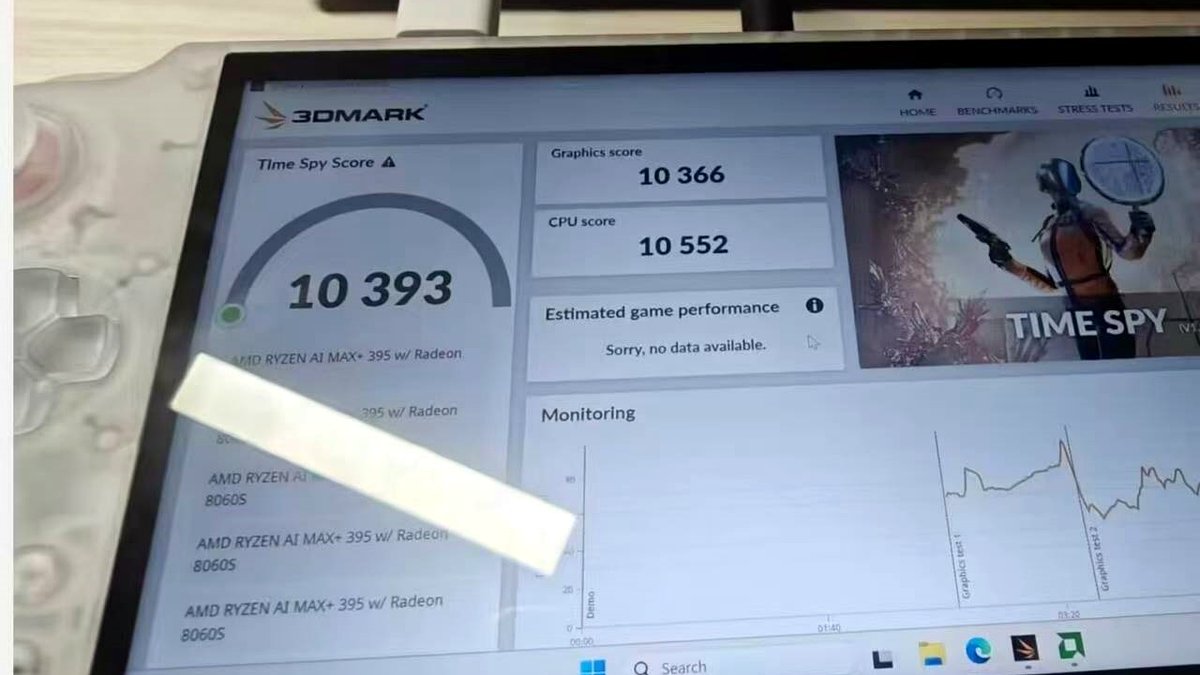A leaked prototype image reveals GPD has developed a gaming handheld powered by AMD's flagship Strix Halo APU, delivering unprecedented handheld gaming performance with over 10,000 points in 3DMark Time Spy graphics testing. Multiple tech outlets report that this test unit showcases the Ryzen AI Max+ 395 processor with integrated Radeon 8060S graphics, potentially representing the most powerful x86 handheld gaming PC ever tested.
Technical Breakthrough in Handheld Performance
The leaked GPD prototype, reportedly spotted by leaker @9550pro on social media, achieves a remarkable 3DMark Time Spy graphics score of 10,366 points Multiple tech outlets report that featuring 16 CPU cores based on the Zen 5 architecture and the RDNA 3.5-based Radeon 8060S integrated graphics processor. Multiple tech outlets report that this configuration enables gaming performance that could handle most modern games at 1080p resolution with high settings at over 60 FPS, though such performance would require significantly higher thermal design power (TDP) than current handhelds.
Design and Potential Product Identity
VideoCardz's analysis suggests the prototype's design resembles the GPD Win 4 form factor but lacks the distinctive slide-up screen mechanism of that device. NotebookCheck's reporting indicates this design difference has led to speculation that the prototype could be an early glimpse of a potential GPD Win 5, though the publication notes uncertainty about whether this will become a commercial product.
The leaked image shows a traditional clamshell handheld design with integrated controls, representing a more conventional approach compared to GPD's recent experimentation with modular and sliding screen designs in their current product lineup.
Market Reality: Cost Challenges and Commercial Viability
Multiple sources highlight the significant cost barrier preventing this prototype from reaching consumers. WCCFtech reports that Strix Halo APUs carry premium pricing, with mini-PCs utilizing the same processor typically priced above $1,500. Technetbooks estimates that a gaming handheld incorporating this level of performance could exceed $2,000, placing it well beyond the reach of mainstream handheld gaming PC buyers.
Multiple tech outlets report that the extreme cost implications have led insiders to suggest this prototype was developed primarily for internal testing and evaluation purposes rather than as a commercially viable product. The publication notes that even GPD, known for premium handheld pricing, may find this configuration economically unfeasible for mass production.
Industry Context and Competitive Landscape
This leak emerges as the handheld gaming PC market experiences unprecedented competition and innovation. Current market leaders including the Steam Deck OLED, ASUS ROG Ally X, and Lenovo Legion Go typically achieve 3DMark Time Spy graphics scores in the 3,000-4,000 point range, making the leaked GPD prototype's 10,366 score a significant performance leap.
The timing coincides with broader industry developments, including Microsoft's partnership with ASUS for Xbox-branded handhelds and Valve's expansion of SteamOS to third-party devices. However, the extreme cost requirements for Strix Halo implementation suggest this level of performance may remain experimental rather than becoming a new market standard.
Critical Analysis: Performance vs. Practicality
While the leaked prototype demonstrates impressive technical capabilities, several factors limit its practical significance for the broader handheld gaming market. The power requirements for sustained high-performance operation would likely necessitate larger battery capacity and enhanced cooling solutions, potentially compromising the portability that defines handheld gaming devices.
The projected pricing of over $2,000 would position such a device in direct competition with high-end gaming laptops rather than traditional handheld competitors. This pricing reality suggests that even if GPD chose to commercialize this design, it would target an extremely niche market segment of enthusiasts willing to pay premium prices for maximum portable performance.
Conclusion
The GPD Strix Halo prototype leak provides a fascinating glimpse into the technical possibilities for future handheld gaming PCs, demonstrating that desktop-class gaming performance can be achieved in portable form factors. However, the economic realities of component costs and market positioning suggest this remains an experimental showcase rather than a preview of commercially viable products.
For the broader handheld gaming PC market, this leak reinforces the ongoing tension between performance capabilities and mass market accessibility. While manufacturers continue pushing technical boundaries, practical considerations of battery life, thermal management, and pricing will likely keep extreme performance configurations as specialized experiments rather than mainstream offerings.
Sources
Note: All sources have been verified for accuracy and editorial standards compliance.
